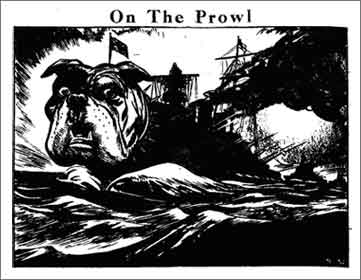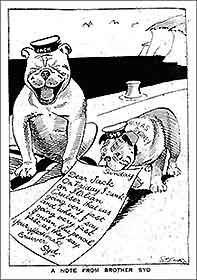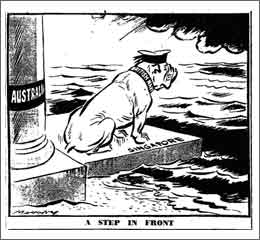| Contents > “Roar Britannia?” by Bridget Deane |
| Page 1 | 2 | 3 | 4 | 5 | 6 |
Why the title “Roar Britannia?” Excuse the pun on the well-known song “Rule Britannia”. Lions roar and Britain was, and still is symbolised by a lion (three lions on a shirt – sporting teams). However, when it came to the defence of areas in the Far East, for example, Malaya, the lion seemed to have been caught napping (Fig.1). This lion was certainly not roaring; instead, it needed to wake up to the seriousness of events unfolding in the Far East.
Next “Britannia Rules the Waves”: at great expense a naval base had been constructed on Singapore Island. In times of emergency this was to house a British naval fleet and act as a deterrent for any country that considered acting aggressively towards British interests or the dominions of Australia and New Zealand – the “Singapore Strategy”. In late 1941 what was sent to Singapore was not the main fleet or even a ‘flying squadron’ of ships but Force Z, which consisted of six ships, (Murfett, 2002, pp. 16-18) including HMS Prince of Wales and HMS Repulse. The Royal Navy had always had a major role in the defence of Britain and its empire; now this was to be put to the test at Singapore.
The characterisation of the Royal Navy as a bulldog was used by a number of cartoonists, for example, Sidney Strube and Ian Gall. Note the gentle humour of Strube’s drawing (Fig. 2), compared to the aggressive stance that Gall has given his bulldog battleship, complete with spiked collar and guns bristling over the side (Fig. 3). ‘Jack' and ‘Syd’ are enjoying the success of HMAS Sydney’s sinking of an Italian cruiser, while a fierce bulldog ploughs through the waves in search of the enemy.


(from left to right) Figure 2. Ian Gall, Courier Mail, July 11, 1940 / Figure 3. Sidney Strube Daily Express, July 22, 1940
‘A STEP IN FRONT’ drawn by Bill Mahony, appeared on 4 December 1941, a few days before Japan launched its offensive. Here a bulldog is sitting on a step (Singapore) looking determinedly out to sea, and all under a gathering black cloud (threat from Japan). At the rear of the bulldog is a pillar (Australia) standing solidly behind Britain. The cartoon implies that the Royal Navy, based at Singapore would protect Australia, while the caption emphasises how important Singapore was to the defence of the country.

Figure 4. Sydney Daily Telegraph December 4, 1941 Bill Mahony
A report in the Sydney Morning Herald (Singapore Bastion, 7 December, 1941) praised the island - ‘But Singapore is much more than a naval base. It is an immense airbase and military garrison. Indeed it is the centre of British military and air power in the East.’ This assessment of Singapore’s strength was, as we now know, optimistic and inaccurate, but the newspaper was only reiterating propaganda about the ‘Gibraltar of the Far East’ (Warren, 2002, p9). As Ian Morrison (1943), war correspondent for The Times (London), wrote in his book Malayan Postscript:
-
By October 1941 the Singapore legend was really well established. British and American newspaper men had visited Singapore and written glowing articles about it. British statesmen talked confidently about its strength. It had become fashionable to refer to it as “the fortress of Singapore”, or often, as “the impregnable fortress of Singapore.” The legend had already achieved a world-wide currency (p. 3).
The role of the Navy was cut short, when on 10 December, 1941 the capital ships from Force Z, HMS Prince of Wales and Repulse, were sunk off the coast of Malaya following an aerial bombing attack by the Japanese; the defence of Malaya now rested with the army and airforce. However, by the end of December, the combined British, Australian and Indian forces were engaged in a defensive retreat down the Malaya peninsula. A report by a ‘special correspondent of the Australian Associated Press’ in the Hobart Mercury (Failures of Strategy, 23 December, 1941)summarised the situation:
-
After a fortnight of fighting we have lost Perlis, Kedah Province, Wellesley, Penang, and the north-eastern corner of Malaya … The people of Malaya are beginning to ask “Why?” For two years the people of Malaya, of Australia, and indeed of the whole world have been told time and again that the defences of Malaya were impregnable, yet in a short period strategic defensive areas have been lost and Singapore itself, the “world’s strongest fortress” has been put on the defensive, perhaps in jeopardy. …
Additionally, the Japanese had gained superiority in the air. Quite simply, the RAF (and RAAF) lacked fighter aeroplanes and were unable to offer much protection against enemy aerial attacks or provide air support for the land forces. This fact seems to have been well known in both Australia and Britain. The Sydney Daily Mirror declared that '“Singapore’s fate depends on planes. Unless adequate air reinforcements are made available promptly only a miracle can save Singapore”' (quoted in the Daily Mirror (London), If Singapore Falls …, 16 January, 1942). Richard Brown, a designer for an engineering works in Ipswich, commented in his diary that, ‘The stark damnable tragedy of the whole situation, too, is our lamentable weakness in the air’. He continued, ‘Someone ought to be disembowelled for that. Even in peace time it [Singapore] ought to be better defended’ (February 10, 1942). The news from the Far East (or ‘Near East’ if you lived in Australia) could not have filled the public in both Britain and Australia with confidence, especially after the surrender of Hong Kong on Christmas Day. There seemed to be no way of stopping the Japanese push southwards towards Singapore.
| Page 1 | 2 | 3 | 4 | 5 | 6 |
| Contents > “Roar Britannia?” by Bridget Deane |
